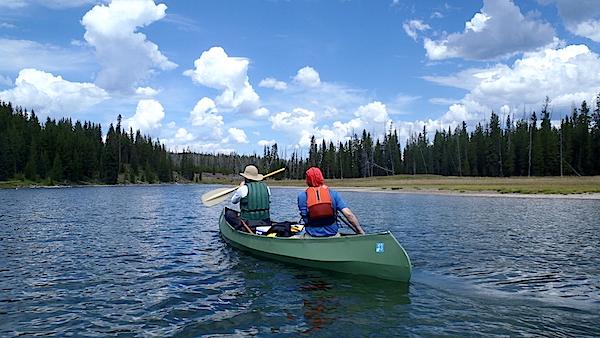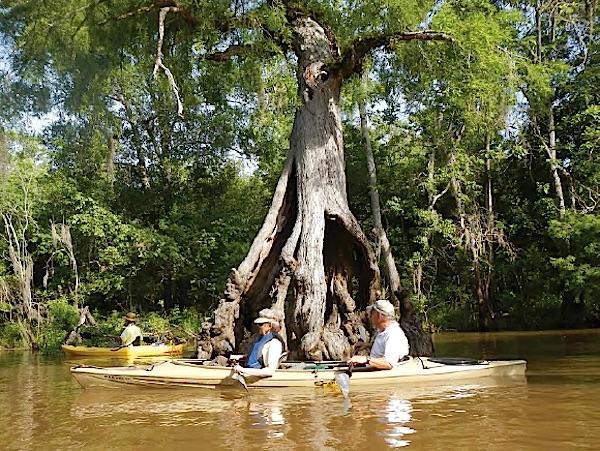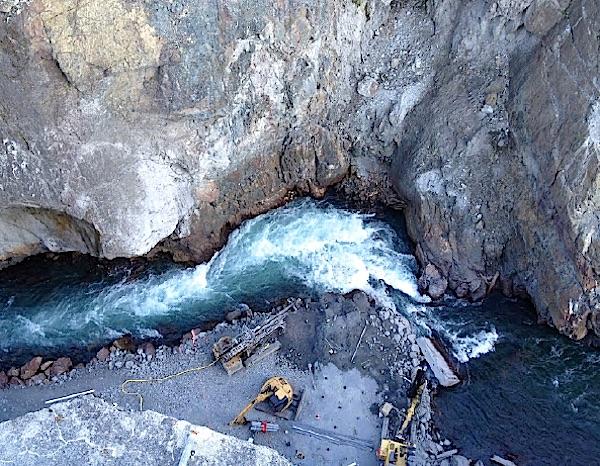
Whether you paddle in Yellowstone National Park (above), Dinosaur National Monument (above) or anywhere else in the National Park System, you can help the National Parks Conservation Association keep the waters healthy/Kurt Repanshek photos
is is the comment.Editor's note: This is a special advertiser-supported article from the 2nd Annual Essential Guide to Paddling the Parks.
The National Park System offers countless paddling opportunities...as well as impediments to paddling. There are free-flowing, gin-clear streams, and pollution threats in the form of fracking operations, agriculture, and population growth. And there are experiences that will pull you into wilderness settings that seemingly turn the calendar back a century or more.
Tracking these issues, and working to improve the health of streams, lakes, and even ocean waters being squeezed by society, is the National Parks Conservation Association.
Whether you're searching for a put-in along the Chesapeake Bay, looking to paddle the recently unchained waters of the Elwha River in Olympic National Park, desiring a truly unique paddling experience, or are concerned about the health of the waters you frequently paddle, NPCA can point you to a program to get involved with.
Exploring Jamaica Bay At Gateway National Recreation Area
Gateway National Recreation Area in the metropolitan New York-New Jersey area contains a sprawling waterfront and salt marsh that is a resting stop for migratory waterfowl, also providing fishing, and nautical mile after nautical mile of paddling.
More than a half-dozen launch sites are sprinkled around the 9,000-acre Jamaica Bay unit of Gateway that embraces the Jamaica Bay Wildlife Refuge. Grab a permit at the Ryan Visitors Center and set off to explore islands from your boat (the islands are protected and off-limits), marshy areas that provide habitat for some of the more than 300 bird species here, and a unique ecosystem that provides valuable mainland protection from hurricanes and other Atlantic storms.
Launch into Mill Basin Outlet from Floyd Bennett Field and you could spend half-a-day paddling through the heart of the wildlife refuge. You could easily turn that into a full-day adventure by threading your way through the 'Pumpkin Patch' islets and heading towards Yellow Bar or the Black Wall before returning to the put-in.
The Wonderful Chesapeake Watershed
A key NPCA initiative in the Mid- Atlantic region is improve both the health and public access to the waters of the Chesapeake. Staff are working to broaden the 'Freedom to Float' program that expands recreational access to the Chesapeake Bay and its streams and rivers.
NPCA is also a leader in a coalition seeking to reduce pollution significantly in the six Chesapeake states and the District of Columbia by 2025 in order to secure fishable, swimmable waters in and around the national parks. NPCA is also working to protect national park rivers and water trails from harmful energy-related infrastructure and development, such as proposed electric transmission towers across the James River in Virginia and impacts from hydraulic fracturing on the Delaware River basin.
The Chesapeake and its tributaries also serve as outdoor classrooms. Over the past year, NPCA has worked with stakeholders to take more than 1,000 youth canoeing in the region. Stewardship also involves adults, who have helped clean up an estimated 200,000 pieces of debris from park shorelines in the watershed.
Protecting Biscayne's And Everglades' Waters
Renowned as a winter vacation destination, south Florida's national parks are idyllic, but not without threats. At Biscayne National Park, the once-rich fisheries and colorful coral reef ecosystems are stressed by over-fishing, boaters, and climate change. The results are visible in smaller catch size of some species, damaged reefs and sea grass beds and, in extreme cases, vandalized archaeological sites. All lead to a potentially disappointing experience by the visitor.
To combat some of the problems, park officials are considering the creation of a marine reserve zone in part of the park that would be closed to fishing. 'Marine reserves are the best, science-based way to protect and sustain coral reef ecosystems and fisheries populations,' says Caroline McLaughlin of the NPCA's Sun Coast staff. 'We truly hope the park prioritizes conservation and decides to create a much-needed marine reserve within Biscayne National Park. The reserve would provide a high-quality diving and snorkeling experience, especially along the park's first-ever Maritime Heritage Trail, for the more adventurous traveler.'
Next door at Everglades National Park, officials would like to create a wilderness waterway around the Ten Thousand Islands area, a mesmerizing part of the park flush with wildlife and paddling adventures.

Jan and Rod Ruppel at the Madonna Tree on the new TP&W paddling trail at Big Thicket National Preserve/NPCA
is the comment.Padding Through An International Biosphere Reserve
A paddler's paradise resides within Big Thicket National Preserve near the Texas border with Louisiana. It's a geologically and botanically unique paradise at that, one shaped dramatically by the last ice glacial period.
Within the park are southeastern swamps, eastern forests, central plains, and southwest deserts. So important is this collection of ecosystems that in 1981 Big Thicket was designated a UNESCO International Biosphere Reserve. Two decades later, it was declared a Globally Important Bird Area.
Launch your canoe or kayak into either Village Creek or the Neches River and you'll float through a veritable botanical crossroads. Come ashore for a break and look closely in the forest duff for tiny, brightly colored, carnivorous plants. Of the five species found in the United States, four grow in Big Thicket.
The 21-mile Village Creek Paddling Trail arguably is the most popular inland paddling experience in Texas. Choose the Neches River and you can paddle 80 miles through bottomland hardwood forests. It's a watery, leafy landscape that can be explored in a day trip, or over the course of a week.
But paradise is not without threats: Poaching, illegal dumping, and development on the preserve's borders all are concerning.
Red-Rock And Whitewater In The Southwest
Expanses of high desert are cut by mighty rivers here on the Colorado Plateau of the Southwest. In Utah the Yampa, Green, Colorado, and San Juan are names well-familiar to most paddlers. But how vigorous can these rivers remain under the steady pressures of development and climate change, which is expected to bring more frequent, and longer-lasting, droughts?
NPCA is watching as the National Park Service works with the U.S. Bureau of Reclamation to develop the 'Long Term Experimental Management Plan' that will dictate how the Glen Canyon Dam that holds back Lake Powell is operated. How that plan is written will directly impact Colorado River flows, sand bar creation, wildlife habitat, and even the condition and protection of archaeological sites along the river as it flows through Grand Canyon National Park.
The threat of longer lasting drought has NPCA staff working with stakeholders throughout the region to see how recreational and environmental values up and down the Colorado River can be maintained in the face of agricultural, municipal, and industrial pulls on the river.
Waterworks In Yellowstone And Grand Teton National Parks
Though world-famous for its thermal features, Yellowstone National Park offers some of the best lake paddling in the Lower 48, while the Snake River in Grand Teton National Park next door showcases Rocky Mountain grandeur from one of the West's fabled rivers.
At Yellowstone, the trio of Lewis, Shoshone and Yellowstone lakes offers both a place to work on your paddling skills, and to advance to backcountry traveler by kayak or canoe. While Lewis is for day trips, the other two lakes offer the consummate wilderness experience'potentially tricky waters, incredible vistas, wildlife that can include grizzlies and wolves.
Though Grand Teton is a prized destination for many because of its crags, the Snake River not only is a blue-ribbon trout fishery, but a cold, challenging, fast-flowing stream perfect for rafting and demanding for canoeists and kayakers. The park's Jenny, Leigh and String lakes are great for day trips, while multi-day trips can be mapped out on Jackson Lake.
Threats of invasive species'New Zealand mudsnails already have made inroads to the park's waters' require inspections of your canoes/ kayaks when you stop to pickup a permit. Keep them clean, and the waters healthy.

Glines Canyon Dam once stood here/Kati Schmidt, NPCA
A Watershed Moment In Olympic National Park
The biggest riverine story of the new, and last, century has been the demolition of the Elwha and Glines Canyon dams in and just downstream of Olympic National Park. Their removal expanded 5 miles of free-flowing river more than 14-fold. In the process, it opened habitat for five species of salmon in numbers expected to be upwards of 300,000 a year, to reclaim the Elwha. This natural revival is important to the Lower Elwha Klallam Tribe whose culture long has depended on a healthy fishery; important to creating rich riparian habitat; and critical to bringing grins to rafters and paddlers who want to explore the river.
While rafting guides can take paddlers through class I-IV rapids, for those looking to experience the Elwha River on dry land, head to a viewpoint of the remains of the Glines Canyon Dam. A small parking area and viewpoint can be reached by following the gravel Whiskey Bend Road about one mile south from its intersection with the Olympic Hot Springs Road. While the dams may be gone, full river restoration is still at least 30 to 100 years away. Fisheries staff will continue to monitor the river's natural recovery while leading a massive revegetation program to introduce 400,000 native plants along the banks of the new river channel.
NPCA supports legislative efforts to designate the Elwha and 18 other surrounding waterways as Wild and Scenic, to prevent the prospect of future dams and support the continued revitalization of the watershed.
Olympic isn't the only paddling friendly national park in the Northwest. San Juan Island National Historical Park offers some of the best sea kayaking in the region, while Lake Roosevelt National Recreation Area is popular with canoeists and kayakers. Further south, last year's approved expansion of Oregon Caves National Monument in Oregon will protect the headwaters of River Styx/Cave Creek.
To learn more about what NPCA is doing to protect your national park waters, and to find out how you can help, visit npca.org.



Comments
A nice reminder that there are some exceptional park experiences to be enjoyed via the water. Glad to see mention of the Big Thicket; not a well-known area, but there some fascinating areas tucked away in that park that are only accessible with a little paddling - and there are so many of those spots, you're likely to have the one you choose virtually to yourself.